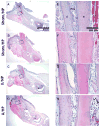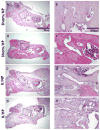Characterization of mandibular bone in a mouse model of chronic kidney disease
- PMID: 20151810
- PMCID: PMC2862731
- DOI: 10.1902/jop.2009.090379
Characterization of mandibular bone in a mouse model of chronic kidney disease
Abstract
Background: Chronic kidney disease (CKD) is a worldwide health problem with increasing prevalence and poor outcomes, including severe cardiovascular disease and renal osteodystrophy. With advances in medical treatment, patients with CKD are living longer and require oral care. The aim of this study is to determine the effects of CKD and dietary phosphate on mandibular bone structure using a uremic mouse model.
Methods: Uremia (U) was induced in female dilute brown agouti/2 mice by partial renal ablation. Uremic mice received a normal-phosphate (NP) or a high-phosphate (HP) diet. sham surgeries were performed in a control group of mice; half received an NP diet, and the other half was fed an HP diet. At termination, animals were sacrificed, and mandibles were collected for microcomputed tomography (micro-CT) and histologic analysis.
Results: Sera levels of blood urea nitrogen, parathyroid hormone, and alkaline phosphatase were significantly increased in U/NP and U/HP mice versus sham controls, whereas serum calcium was increased in the U/HP group, and no differences were noted in serum phosphate levels among groups. Micro-CT analyses revealed a significant reduction in cortical bone thickness and an increase in trabecular thickness and trabecular bone volume/tissue volume in U/NP and U/HP groups compared to the sham/NP group. A significant reduction in cortical bone thickness was also found in the sham/HP group versus the sham/NP group. Histologic evaluation confirmed increased trabeculation in the U groups.
Conclusion: CKD in mice, especially under conditions of HP feeding, results in marked effects on alveolar bone homeostasis.
Conflict of interest statement
No conflicts for any authors
Figures






Similar articles
-
High phosphate feeding promotes mineral and bone abnormalities in mice with chronic kidney disease.Nephrol Dial Transplant. 2013 Jan;28(1):62-9. doi: 10.1093/ndt/gfs333. Epub 2012 Oct 8. Nephrol Dial Transplant. 2013. PMID: 23045434 Free PMC article.
-
Dentoalveolar Alterations in an Adenine-Induced Chronic Kidney Disease Mouse Model.J Bone Miner Res. 2023 Aug;38(8):1192-1207. doi: 10.1002/jbmr.4829. Epub 2023 May 27. J Bone Miner Res. 2023. PMID: 37191192 Free PMC article.
-
The effects of sevelamer hydrochloride and calcium carbonate on kidney calcification in uremic rats.J Am Soc Nephrol. 2002 Sep;13(9):2299-308. doi: 10.1097/01.asn.0000025782.24383.0d. J Am Soc Nephrol. 2002. PMID: 12191974
-
Severe jaw enlargement associated with uremic hyperparathyroidism.Hemodial Int. 2008 Jul;12(3):316-8. doi: 10.1111/j.1542-4758.2008.00273.x. Hemodial Int. 2008. PMID: 18638085 Review.
-
Adynamic bone disease is a predominant bone pattern in early stages of chronic kidney disease.J Nephrol. 2017 Oct;30(5):629-634. doi: 10.1007/s40620-017-0397-7. Epub 2017 Apr 12. J Nephrol. 2017. PMID: 28405928 Review.
Cited by
-
Ammonia promotes the proliferation of bone marrow-derived mesenchymal stem cells by regulating the Akt/mTOR/S6k pathway.Bone Res. 2022 Aug 26;10(1):57. doi: 10.1038/s41413-022-00215-y. Bone Res. 2022. PMID: 36028500 Free PMC article.
-
High-fat diet-induced obesity triggers alveolar bone loss and spontaneous periodontal disease in growing mice.BMC Obes. 2016 Jan 8;3:1. doi: 10.1186/s40608-016-0082-8. eCollection 2015. BMC Obes. 2016. PMID: 26793316 Free PMC article.
-
Nephrectomy Induces Severe Bone Loss in Mice Expressing Constitutively Active TGFβ Receptor Type I.Int J Mol Sci. 2025 Mar 17;26(6):2704. doi: 10.3390/ijms26062704. Int J Mol Sci. 2025. PMID: 40141345 Free PMC article.
-
Chronic Kidney Disease Impairs Bone Defect Healing in Rats.Sci Rep. 2016 Mar 9;6:23041. doi: 10.1038/srep23041. Sci Rep. 2016. PMID: 26955758 Free PMC article.
-
Effect of chronic kidney disease on the healing of titanium implants.Bone. 2013 Oct;56(2):410-5. doi: 10.1016/j.bone.2013.07.014. Epub 2013 Jul 19. Bone. 2013. PMID: 23876979 Free PMC article.
References
-
- Chronic Kidney Disease (CKD) [Accessed: April 29, 2009]. Available at: http://www.kidney.org/kidneydisease/ckd/index.cfm#facts.
-
- Levey AS, Eckardt KU, Tsukamoto Y, et al. Definition and classification of chronic kidney disease: a position statement from Kidney Disease: Improving Global Outcomes (KDIGO) Kidney Int. 2005;67:2089–2100. - PubMed
-
- Moe S, Drueke T, Cunningham J, et al. Definition, evaluation, and classification of renal osteodystrophy: a position statement from Kidney Disease: Improving Global Outcomes (KDIGO) Kidney Int. 2006;69:1945–1953. - PubMed
-
- Cozzolino M, Dusso AS, Slatopolsky E. Role of calcium-phosphate product and bone-associated proteins on vascular calcification in renal failure. J Am Soc Nephrol. 2001;12:2511–2516. - PubMed
-
- Ganesh SK, Stack AG, Levin NW, Hulbert-Shearon T, Port FK. Association of elevated serum PO(4), Ca x PO(4) product, and parathyroid hormone with cardiac mortality risk in chronic hemodialysis patients. J Am Soc Nephrol. 2001;12:2131–2138. - PubMed
Publication types
MeSH terms
Substances
Grants and funding
LinkOut - more resources
Full Text Sources
Medical
Research Materials
Miscellaneous

